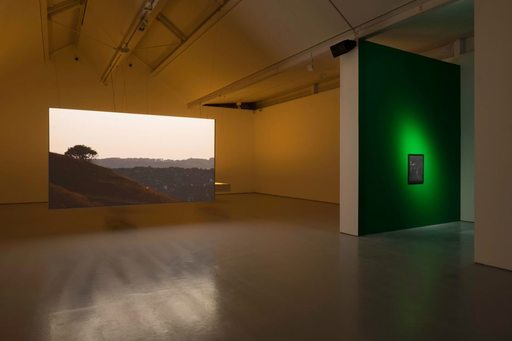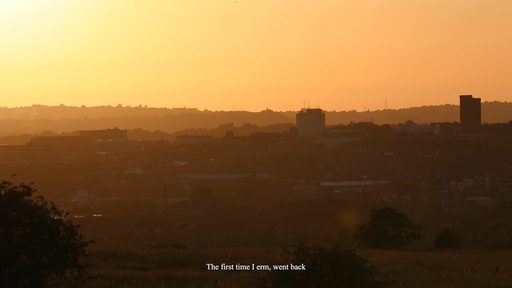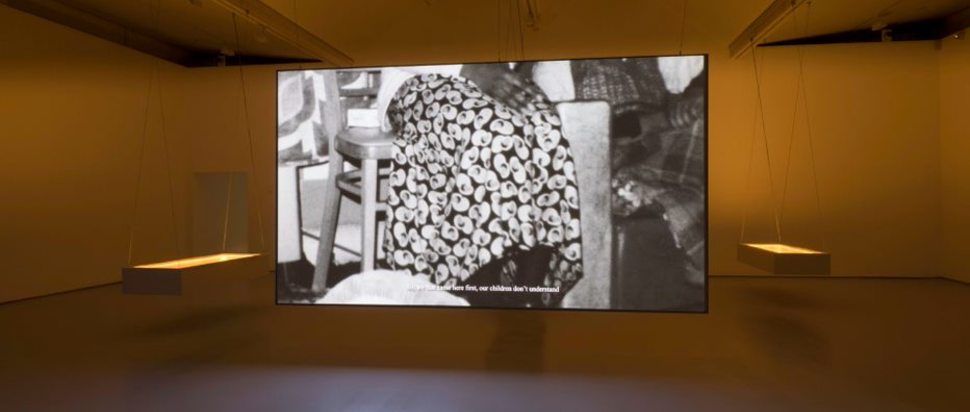Portraits of Home: Matthew Arthur Williams at DCA
Matthew Arthur Williams’ revelatory exhibition Soon Come contemplates meanings of home and how the labour of certain communities is rendered invisible
A striking black and white self-portrait of artist Matthew Arthur Williams greets you as you enter the first gallery space at Dundee Contemporary Arts. He looks directly at the camera, elbows balanced on his knees, arms gracefully crossed across his body – his right hand clutching the shutter release. This direct gaze, which bell hooks calls the ‘oppositional gaze’, both establishes the presence of the artist and invites the viewer to question the power that their own gaze holds. These self-portraits place Williams in succession, and in conversation, with queer artists using self-portraiture as an act of radical self-making and space-taking – including Ajamu X (who the artist has previously collaborated with), the late Rotimi Fani-Kayode and the visual activist Zanele Muholi.
Williams is a Glasgow-based visual and sound artist, DJ and photographer, and Soon Come is his first (and long overdue) solo exhibition in a major UK institution. The title Soon Come has many registers. It draws attention to the temporalities of the Caribbean, of differing attitudes towards presence and absence, arrival and departure. An attempt to become comfortable with the discomfort of the uncontrollable and the unknowable – influenced, perhaps, by the annual threat of the Atlantic hurricane season to the islands of the Caribbean. Williams’ use of mostly analogue techniques draws attention to these wavering and warping temporalities.

Installation view of Soon Come. Photo: Ruth Clark
While precision in regard to the timing process of darkroom photography is fundamental, there is also a distinct slowness in comparison to the immediacy of digital techniques. Analogue processes also bare the influence of the artists’ hand and body, inscribing a physicality that is often absent from digital forms. Here, there is a clear refusal of forms of rapid making, with Williams highlighting the importance of a contemplative yet attentive process in making considered and critical work.
In the first gallery, a flat, square plinth sits at the centre of the space. Photographs show Williams’ grandfather’s bus service medals, rows of terraced houses and the chimneys that once served Stoke-on-Trent’s burgeoning ceramics industry. Williams curiously plays with scale, the photograph of a pin badge taking up as much space as that of the colossal, bottle-like chimneys. This experiment with scale is perhaps an attempt to question why histories of certain communities are made dominant, while others are rendered invisible. Histories of industry in places such as Stoke-on-Trent are often tied to whiteness, despite the fact that people of colour have been present in these spaces for centuries – and that the raw materials used in these industries came from other parts of the world, including the Caribbean.

Still from Soon Come by Matthew Arthur Williams
The exhibition contests the invisibilisation of the labour of people who came to Britain from elsewhere. This is the labour, yes, of the generation of people from the Caribbean who arrived in the UK as part of the ‘Windrush generation’ – but also of the prolonged histories of enslavement and indenture that built the financial, architectural and social fabric of Britain. These long histories intertwine post-industrial communities such as Stoke-on-Trent, Liverpool and Glasgow with communities in the Caribbean, and beyond.
The central film and sound installation, installed across two opposing screens, fuse the sounds, landscapes and bodies of both Jamaica and Britain together. Images of landscapes left with the legacies of industry are overlaid with voices describing stories of migration and interconnectivity between these two islands. Next to the film installation, three vitrines are suspended from the ceiling, quiet and spectral. Containing a number of Williams’ photographic prints, they appear coffin-like, creating a duality with the image of a coffin-shaped hole in the ground, surrounded by polished shoes and formal attire.
Williams’ exhibition formulates a living, breathing archive, one invested in bodies and voices rather than written and institutional records. Indeed, many of the photographs displayed on the walls surrounding the installations are images from Williams’ personal photographic archive. As you leave the gallery, another of Williams’ self-portrait’s bids you farewell, a powerful invocation of an eternal ancestral presence – and perhaps an invitation to meet again soon.
Soon Come continues at Dundee Contemporary Arts until 26 Mar
